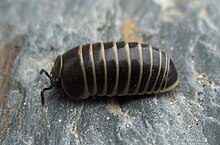
Summary
Glomeris marginata is a common European species of pill millipede. It is a short millipede, rounded in cross-section, which is capable of rolling itself up into a ball ("volvation") when disturbed. This behaviour is also found in the pill woodlouse Armadillidium, with which G. marginata is often confused.[2]
| Glomeris marginata | |
|---|---|

| |
| Scientific classification | |
| Domain: | Eukaryota |
| Kingdom: | Animalia |
| Phylum: | Arthropoda |
| Subphylum: | Myriapoda |
| Class: | Diplopoda |
| Order: | Glomerida |
| Family: | Glomeridae |
| Genus: | Glomeris |
| Species: | G. marginata
|
| Binomial name | |
| Glomeris marginata (Villers, 1789)
| |
| Synonyms | |
|
Oniscus marginata Villers, 1789 [1] | |
Distribution edit
Glomeris marginata is found throughout central and north-western Europe, from Poland and Scandinavia to Spain and Italy.[3] In the British Isles, it is found in all areas south of the Central Belt of Scotland.[4]
Description edit
Glomeris marginata grows up to 20 millimetres (0.8 in) long and 8 mm (0.3 in) wide, and is covered by twelve black dorsal plates with white rims.[5][6] Each segment except those at the front and back bears two pairs of legs, with around 18 pairs in total.[5] This distinguishes pill millipedes from pill woodlice, both of which are called "pillbugs" — woodlice have 7 pairs of walking legs, one per body segment, while millipedes have more pairs, and with two pairs to each apparent body segment.
When rolled into a ball, G. marginata can be distinguished from a rolled–up pill woodlouse by the asymmetrical ball it rolls into; pill woodlice roll into much more perfect spheres.[7] The cuticle is also darker and shinier, and the antennae are shorter.[8] The head and tail of a woodlouse have a greater number of small plates, while the head of Glomeris is protected by a single large shield, and it lacks the uropods of woodlice at the read end.[5] Although usually black, red, yellow and brown individuals do occasionally occur.[2]
Ecology edit
Glomeris marginata lives in leaf litter as well as in grass and under stones, with a preference for calcareous soils.[2] In domestic gardens, they are most frequent along hedgerows and at the bases of old walls, where the mortar has started to crumble, leaching lime into the soil.[5][8] It is less prone to desiccation than other millipedes and can be found in the open, even in sunny weather,[6] although they are more active at night and prefer more humid areas.[2] G. marginata feeds on old, rotting leaves, despite the higher nutrient content of freshly–fallen leaves, and G. marginata can be responsible for recycling a significant proportion of the nutrients in the leaf litter.[9]
Predators of Glomeris marginata are reported to include the starling, the common toad, the woodlouse spider,[8] and hedgehogs.[6] As well as rolling up into a ball for protection, G. marginata produces noxious chemicals to ward off potential predators, as many millipedes do. One to eight drops of a viscid fluid are secreted, containing the quinazolinone alkaloids glomerin and homoglomerin, dissolved in a watery protein matrix.[10] These chemicals act as antifeedants and toxins to spiders, insects and vertebrates, and the fluid is sticky enough to entrap the legs of ants.[10] Having completely discharged these chemical defences, it can take up to four months for the millipede to replenish their supplies.[10]
Reproduction and life cycle edit
Breeding takes place cyclically in spring and summer. Male G. marginata are capable of producing a pheromone which attracts females, although this is only believed to be effective over short distances.[11] They then transfer sperm to the female using their gonopods, specially modified legs. After fertilisation, the females lay 70–80 eggs, each about 1 mm long, and each wrapped singly in a capsule of digested earth.[2] The eggs hatch after a period of about two months, with the duration depending on factors including temperature.[6] Development lasts for up to three years, and involves nine moults, following which moults occur periodically as adults.[2] Females are fertile for several years, and can produce six broods over their lifetime,[6] which can be up to eleven years.[2]
References edit
- ^ "Oniscus marginata Villers, 1789". Universität Ulm. Archived from the original on March 3, 2016. Retrieved June 21, 2007.
- ^ a b c d e f g "Pill millipede (Glomeris marginata)". ARKive. Archived from the original on 2009-11-25. Retrieved June 21, 2007.
- ^ "Glomeris marginata". EUNIS biodiversity database. European Environment Agency. Retrieved June 21, 2007.[permanent dead link]
- ^ "Grid map of records on the Gateway for Pill Millipede (Glomeris marginata)". National Biodiversity Network. Retrieved June 21, 2007.
- ^ a b c d Stuart M. Bennett (2000). "Glomeris marginata (the pill millipede)". Retrieved June 21, 2007.
- ^ a b c d e "Pill millipede". Animal Encyclopedia. Retrieved June 21, 2007.[better source needed]
- ^ "Details for Glomeris marginata (Villers, 1789)". National Biodiversity Network's Species Dictionary. Natural History Museum. Archived from the original on May 20, 2009. Retrieved June 21, 2007.
- ^ a b c "Pill millipede — Glomeris marginata". English Nature. Archived from the original on September 27, 2007. Retrieved June 21, 2007.
- ^ J.–F. David & D. Gillon (2002). "Annual feeding rate of the millipede Glomeris marginata on holm oak (Quercus ilex) leaf litter under Mediterranean conditions". Pedobiologia. 46 (1): 42–52. doi:10.1078/0031-4056-00112.
- ^ a b c James E. Carrell (1984). "Defensive secretion of the pill millipede Glomeris marginata". Journal of Chemical Ecology. 10 (1): 41–51. Bibcode:1984JCEco..10...41C. doi:10.1007/BF00987642. PMID 24318227. S2CID 23385386.
- ^ Juberthie-Jupeau, Lysiane (1976). "Fine structure of postgonopodial glands of a myriapod Glomeris marginata (Villers)". Tissue and Cell. 8 (2): 293–304. doi:10.1016/0040-8166(76)90053-7.
External links edit
- Media related to Glomeris marginata at Wikimedia Commons


